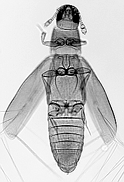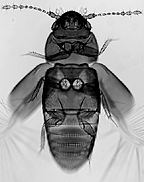Ptiliidae
Featherwing beetles
W. Eugene HallIntroduction
Ptiliidae is a highly diverse yet poorly known group of minute beetles. Approximately 65 genera and over 400 species within three subfamilies have been described worldwide. These numbers are rather conservative, based on the large number of undescribed taxa within existing collections. Acrotrichis is the largest genus, presently containing more than 150 species. Though inhabiting many moderate and tropical regions around the globe (Australia, New Zealand, Japan, South and Central America, Mexico, Africa), only the European taxa have been treated in great depth. Approximately 25 genera and 115 species have been described from America north of Mexico. A key to North American genera is provided by Dybas (1990).
The wing consists of a stalk attached to a long membrane bordered with numerous hairs, giving rise to the common name Featherwing Beetles. Ptiliids represent the smallest known beetles, averaging 0.5 mm to 1.5 mm in length. The extremes range from 0.3 mm ('Nanosella') to 2.0 mm (Acrotrichis godmani). The female spermatheca is a valuable diagnostic character for identifying species, due to its highly variable form. Spermatozoa also exhibit varying characteristics. Female ptiliids develop eggs one at a time within the abdominal region, since egg size is generally half the body length. Morphological polymorphism occurs within some genera (Pteryx, Ptinella, Ptinellodes), usually in the form of 'normal' and 'vestigial' morphs, the latter possessing reduced (or absent) eyes and wings. Some ptiliid genera (Acrotrichis, Bambara, Ptiliopycna) are known to be parthenogenetic.
Adults and larvae of featherwing beetles are usually found together in a variety of habitats including moist leaf litter, mammal nests and dung, rotting cacti, ant and termite colonies, under bark of dead trees, along sand and gravel banks of rivers and streams, beneath seaweed on beaches, and other habitats containing rotting or damp organic material. Some taxa are also specialists of fungi, feeding on the spores produced by the fruiting bodies.
Characteristics
The two most noticeable characteristics of ptiliids are their feathery wings and minute size. The membranous area of their wings is greatly reduced, in most species consisting of only a thin strut. Attached to the edge of the wing are long setae, making up most of the functional surface of the wing.


Hind wing of Ptenidium
Adult ptiliids are extremely small, usually 0.4 to 1.3 mm in length (tropical acrotrichines may reach 2.0 mm). Other adult characteristics include: Tarsi appear 2 or 3-segmented. Antennae generally 11-segmented (some Nanosellinae have 10-segmented antennae; antennae of the cephaloplectine Paralimulodes contain 8 segments). Eyes present, but reduced or lacking in polymorphic groups (Ptinella, Ptinellodes). Cephaloplectines, while not polymorphic, lack eyes entirely, due to a myrmecophile lifestyle. Ptiliid elytra are either long and cover the abdomen, or short and truncate, exposing the abdominal segments. 'Vestigial morphs' of polymorphic forms usually lack body pigment. The female spermatheca (sperm storage organ) is of variable form between species, but constant within species, making it extremely important for species identification.
Ptiliid larvae are also very small, usually under 2.0 mm in length. Body shape is of linear form, and pigmentation white to somewhat yellow. Eyespots normally absent, as well as epicranial and frontal lines. Abdomen 10-segmented, and includes 1 pair of anal hooks and 1-segmented urogomphi (anal hooks absent in Cephaloplectinae; urogomphi absent in Nanosellinae). The maxilla possess a fringed galea (absent in Nanosellinae). Associated with the labrum of Cephaloplectinae are 4 denticles located beneath the anterior margin.
Fossil History
Ptiliid fossils are known from the Oligocene and Holocene. The fossil taxa represent three extant genera: Microptilium, Ptilium and Ptinella.
Discussion of Phylogenetic Relationships
Currently, ptiliids are divided into four subfamilies: Ptiliinae, Nanosellinae, Cephaloplectinae and Acrotrichinae. Presently, there exists no phylogenetic analysis of ptiliid relationships.
References
For more extensive list of ptiliid references, see here.
Arnett, R.A. 1961. Beetles of the United States (A manual for identification). Fasicle 21, Ptiliidae. Catholic University of America Press, Washington, D.C.: pp. 349-352.
Barber, H.S. 1924. New Ptiliidae related to the smallest known beetle. Proceedings of the Entomological Society of Washington 26(6): 167-168.
Besuchet, C. 1971. Ptiliidae. In H. Freude, K.W. Harde, G.A. Lohse (ed.), Die Kafer Mitteleuropus, 3. Krefeld, Goecke und Evers. pp. 311-334.
Besuchet, C. 1976. Contribution a l'etude des Ptiliides palearctiques (Coleoptera). Mitteilungen der Schweizerischen Entomologischen Gesellschaft 49: 51-71.
Blackwelder, R.E. 1944. Checklist of coleopterist insects of Mexico, Central America, the West Indies, and South America. Part I. United States National Museum Bulletin 185: 85-86.
Campbell, J.M. 1991. Family Ptiliidae. In Y. Bousquet (ed.), Checklist of Beetles of Canada and Alaska. pp. 75-76.
Csiki, E. 1911. Coleopterorum Catalogus. Volume VIII. Family Ptiliidae. W.Junk, Berlin: pp. 5-61.
Deane, C. 1930. Trichopterygidae of Australia and Tasmania. Proceedings of the Linnean Society of New South Wales 55: 477-487.
Deane, C. 1931. Trichopterygidae of Australia and adjacent islands. Proceedings of the Linnean Society of New South Wales 56: 237-242.
Deane, C. 1932. Trichopterygidae of Australia and adjacent islands. Proceedings of the Linnean Society of New South Wales 57: 181-196.
Deane, C. 1934. Small beetles. Victorian Naturalist: 242-244.
Dybas,H.S. 1990. Ptiliidae. In Daniel Dindal (ed), Soil Biology Guide. John Wiley and Sons, New York. Chapter 36: 1093-1112.
Flach, C. 1889. Bestimmungstabelle der Trichopterygidae des europaischen Faunengebietes. Verhandlungen der Zoologisch-botanischen Gesellschaft in Wien 39: 481-532.
Hall, W. E. 2001. Ptiliidae. pp. 231-246 in Arnett, R.H., Jr., and M. C. Thomas. (eds.). American Beetles. Volume 1. Archostemata, Myxophaga, Adephaga, Polyphaga: Staphyliniformia. CRC Press LLC, Boca Raton, FL. xvi + 443 pp.
Johnson, C. 1969a. The genus Acrotrichis Motschulsky (Coleoptera: Ptiliidae) in the Ethiopian region (studies on Ethiopian Ptiliidae, no.2). Rev. Zool. Bot. Afr. 79: 213-260.
Johnson, C. 1975c. Five species of Ptiliidae (Col.) new to Britain, and corrections to the British list of the family. Entomologist's Gazette 26: 211-223.
Johnson, C. 1982a. An introduction to the Ptiliidae (Coleoptera) of New Zealand. New Zealand Journal of Zoology 9: 333-376.
Johnson, C. 1982b. Ptiliidae (Coleoptera) from the Galapagos and Cocos Islands. Brenesia 19/20: 189-199.
Johnson, C. 1985. Revision of Ptiliidae (Coleoptera) occurring in the Mascarenes, Seychelles and neighbouring islands. Entomologica Basiliensia 10: 159-237.
Johnson, C. 1987a. Additions and corrections to the British list of Ptiliidae (Coleoptera). Entomologist's Gazette 38: 117-122.
Johnson, C. 1987b. A revised check list of British Acrotrichis Motschulsky (Coleoptera: Ptiliidae). Entomologist's Gazette 38: 229-242.
Johnson, C. 1990b. New observations on Canadian Ptiliidae (Coleoptera). The Coleopterists Bulletin 44(3): 267-268.
Johnson, C. 1992. Additions and corrections to the British list of Coleoptera. Entomologist's Record 104: 305-310.
Johnson, C. 1993. Ptiliidae (Coleoptera) from the Yap Islands. Entomologist's Record 105: 79-83.
Kubota, M. 1943. Notes on some Ptiliidae from Japan. Transactions of the Kansai Entomological Society 13(1): 1-5.
Lawrence, J.F. and A.F. Newton, Jr. 1995. Families and subfamilies of Coleoptera (with selected genera, notes, references and data on family- group names). In J. Pakaluk and S.A. Slipinski (ed.), Biology, Phylogfeny, and Classification of Coleoptera: Papers Celebrating the 80th Birthday of Roy A. Crowson. pp. 779-1006.
Leng, C.W. 1920. Catalogue of the Coleoptera of America, North of Mexico. pp. 132-133.
Matthews, A. 1872. Trichopterygia illustrata et descripta. 188 pp, 30 plates.
Matthews, A. 1884. Synopsis of North American Trichopterygidae. Transactions of the American Entomological Society 11: 113-156.
Matthews,A. 1888. Family Trichopterygidae. In Biologia Centrali-Americana. Insecta: Coleoptera. Vol. II, part I. pp. 126-156.
Matthews, A. 1900. Trichopterygia illustrata et descripta. Supplement. 112 pp, 7 plates.
Mlynarski, J.K. 1984. Materials to the revision of the genus Acrotrichis Motschulsky, 1848 (Coleoptera, Ptiliidae). Acta Zool. Cracov. 27(18): 305- 376.
Motschulsky, V. von. 1868. Enumeration des nouvelles especes de Coleopteres, rapportes de ses voyages. Bulletin de la Societe Imperiale des Naturalistes de Moscou 41(2): 170-192.
Newton, A.F, Jr. and M.K. Thayer. 1992. Current classification and family- group names in Staphyliniformia (Coleoptera). Fieldiana: Zoology (N.S.), 67: 1-92.
Ritter, E. 1909. Familie: Ptiliidae. Fauna Germanica. Die Kafer des Deutschen Reiches. Band II. pp. 265-275.
Seevers, C.H. and H.S. Dybas. 1943. A synopsis of the Limulodidae (Coleoptera): A new family proposed for myrmecophiles of the subfamilies Limulodinae (Ptiliidae) and Cephaloplectinae (Staphylinidae). Annals of the Entomological Society of America, 36: 546-586.
Sharp, D. 1883. Subfamily Cephaloplectinae. In Biologia Centrali-Americana. Insecta. Coleoptera, vol. 1 (2). Taylor and Francis, London. pp. 295-297.
Title Illustrations

| Scientific Name | Cylindrosella dampfi |
|---|---|
| Image Use |
 This media file is licensed under the Creative Commons Attribution-NonCommercial-ShareAlike License - Version 3.0. This media file is licensed under the Creative Commons Attribution-NonCommercial-ShareAlike License - Version 3.0.
|
| Copyright |
© 1995

|
| Scientific Name | Acrotrichinae |
|---|---|
| Location | Arizona |
| Image Use |
 This media file is licensed under the Creative Commons Attribution-NonCommercial-ShareAlike License - Version 3.0. This media file is licensed under the Creative Commons Attribution-NonCommercial-ShareAlike License - Version 3.0.
|
| Copyright |
© 1995

|
| Scientific Name | Cephaloplectinae |
|---|---|
| Location | Oklahoma |
| Image Use |
 This media file is licensed under the Creative Commons Attribution-NonCommercial-ShareAlike License - Version 3.0. This media file is licensed under the Creative Commons Attribution-NonCommercial-ShareAlike License - Version 3.0.
|
| Copyright |
© 1995

|
About This Page
Correspondence regarding this page should be directed to W. Eugene Hall at
Page copyright © 2007
 Page: Tree of Life
Ptiliidae. Featherwing beetles.
Authored by
W. Eugene Hall.
The TEXT of this page is licensed under the
Creative Commons Attribution-NonCommercial-ShareAlike License - Version 3.0. Note that images and other media
featured on this page are each governed by their own license, and they may or may not be available
for reuse. Click on an image or a media link to access the media data window, which provides the
relevant licensing information. For the general terms and conditions of ToL material reuse and
redistribution, please see the Tree of Life Copyright
Policies.
Page: Tree of Life
Ptiliidae. Featherwing beetles.
Authored by
W. Eugene Hall.
The TEXT of this page is licensed under the
Creative Commons Attribution-NonCommercial-ShareAlike License - Version 3.0. Note that images and other media
featured on this page are each governed by their own license, and they may or may not be available
for reuse. Click on an image or a media link to access the media data window, which provides the
relevant licensing information. For the general terms and conditions of ToL material reuse and
redistribution, please see the Tree of Life Copyright
Policies.
- Content changed 19 January 2007
Citing this page:
Hall, W. Eugene. 2007. Ptiliidae. Featherwing beetles. Version 19 January 2007 (under construction). http://tolweb.org/Ptiliidae/9616/2007.01.19 in The Tree of Life Web Project, http://tolweb.org/












 Go to quick links
Go to quick search
Go to navigation for this section of the ToL site
Go to detailed links for the ToL site
Go to quick links
Go to quick search
Go to navigation for this section of the ToL site
Go to detailed links for the ToL site